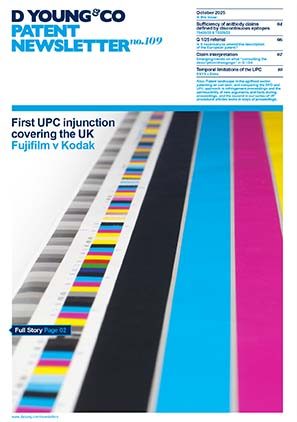T 1946/21: the deadline for transferring right to priority
In T 1946/21, the European Patent Office (EPO) Board of Appeal decided on when a transfer of a right to priority must be effective for a valid claim to priority for a subsequent European patent application.
Background
The decision concerned an appeal by the opponent to a European patent that claimed priority from an earlier Chinese application. The proprietor of the European patent had acquired the right to priority on the last day of the twelve-month priority period and filed the subsequent European application on the same day.
The opponent asserted that the proprietor did not have a right to priority before the filing date and so the priority claim should be invalid. Since the Chinese application had been published before the filing date of the European patent, the Chinese application would be citable as prior art if the priority claim was invalid. The assertion of an invalid priority claim therefore was critical to the opponent’s principal argument of lack of novelty.
The appeal
The opponent proposed two main lines of argument in support of the assertion of an invalid priority claim:
- The precise wording of previous case law (for example, in T 1201/14 and T 0577/11) and the EPO Guidelines state that the transfer must have taken place “before the filing date” of the later application. The opponent relied on this wording to argue that the transfer must have occurred at least on the day before the filing date.
- The smallest unit of time under the European Patent Connvention (EPC) is one day, such as when calculating time periods for deadlines. To suggest smaller units would cause unequal treatment of applicants (for example, filing by post would not provide an exact time of filing whereas filing online would). Additionally, since official EPO documents do not mark a date and time it would be uncertain as to whether the event for one document occurred before another. The opponent therefore argued that, for legal certainty, the transfer must have taken place at least one day before filing the subsequent application.
The proprietor argued that Article 87 granted the right to priority to the successor in title without defining any further requirements as to how this status was achieved. To deprive the proprietor of their legitimate right to priority would be without any good reason.
The proprietor further highlighted that the case law cited by the opponent was not entirely decisive as to whether the transfer must have taken place the day before the filing date.
The Board of Appeal's reasoning
The Board of Appeal largely agreed with the reasoning put forward by the proprietor, noting that Article 87 does not set any condition to enjoy the right of priority other than being the applicant or successor in title of the priority application. Accordingly, the Board of Appeal found that there is no express requirement in law to support the opponent’s position.
The Board of Appeal saw no reason to imply such a requirement into law either. Doing so would mean that the successor in title would have to wait until the day after a transfer of right to enjoy that right. During that waiting time, neither the transferor nor the transferee would be able to make use of their priority right. The Board of Appeal saw no convincing reason to implement such a restriction.
In relation to the opponent’s arguments for legal certainty and equal treatment of applicants, the Board of Appeal noted that it has always been the responsibility of the applicant/proprietor to demonstrate that their priority right is valid. The responsibility is equal among all applicants and whether or not the right is demonstrated is a question of fact that must be proven. Accordingly, the Board of Appeal decided that the arguments in relation to the smallest unit of time were irrelevant, and did not see any reason for legal uncertainty or unequal treatment of applicants.
Conclusions and recommendations
This decision gives some certainty, in that the exact deadline for transferring the right to priority is the moment that the subsequent application is filed. However, applicants should bear the Board of Appeal’s reminder in mind: it is the applicant’s responsibility to demonstrate that the transfer took place before filing the subsequent application. This can be easily demonstrated when the transfer of priority takes place at least one day before the subsequent application is filed. On the other hand, if both events take place on the same day it would not be as clear-cut. So applicants should consider the types of evidence that should be kept to demonstrate a valid right to priority.
In this case, the proprietor successfully proved the time of the transfer using an entry in a otarial journal by a US notary who had witnessed the assignment of the priority right, copies of emails, and several affidavits from the notary and employees of the transferor/transferee. Evidence for the time of filing of the application was the filing receipt that specifies the second at which the application was received by the online filing system.
Fortunately for applicants, this appears to be a fairly low evidential burden that should be met with any well-kept internal records system. It is also clear that if filing a subsequent application close to a deadline, applicants should certainly avoid filing by post, and instead make use of online filing to obtain a time-stamped filing receipt.
For prospective opponents, however, there are significant risks in commencing an opposition with a priority attack, since most of the above evidence is not publicly available. Although the filing receipt will be visible on the European Patent Register, there is no requirement to publish assignments of priority documents in Europe. Without this evidence it would be very risky to start opposition proceedings (including paying all of the fees), only for the proprietor to produce the necessary evidence to entirely negate this line of attack.
When considering whether to file an opposition it could be reasonable to include a priority attack if the applicants for the first and subsequent applications are different. However, there should be strong back-up attacks in case the proprietor can produce sufficient evidence as in this case.
In a worst case scenario this would be dealt with fairly quickly at the beginning of the opposition proceedings before moving onto stronger attacks. However, in a best case scenario, the priority attack could give rise to a very strong novelty attack based on the priority document (if published). These possible strategies should be discussed with a patent attorney before any significant steps are taken.
Finally, it is worth noting that the Board of Appeal did not formally decide whether the proprietor’s evidence was sufficient since it was not contested by the opponent. Perhaps in future cases the quality of evidence for when the transfer took place may be assessed with more scrutiny.
Case details at a glance
Jurisdiction: European Patent Office
Decision level: Board of Appeal
Parties: Bestway Europe Spa & Bestway Deutschland GmbH and Intex Recreation Corp
Citation: T 1946/21
Date: 05 May 2023
Useful links
- T 1201/14 (Transfer of right of priority), EPO Boards of Appeal, 09 February 2017: dycip.com/t-1201-14
- T 0577/11 (Entitlement to priority), EPO Boards of Appeal, 14 April 2016: dycip.com/t-0577-11
- EPO Guidelines for Examination: Part A, Chapter III, 6.1 Claim to Priority: General Remarks: dycip.com/epoguidelines-priorityclaim

